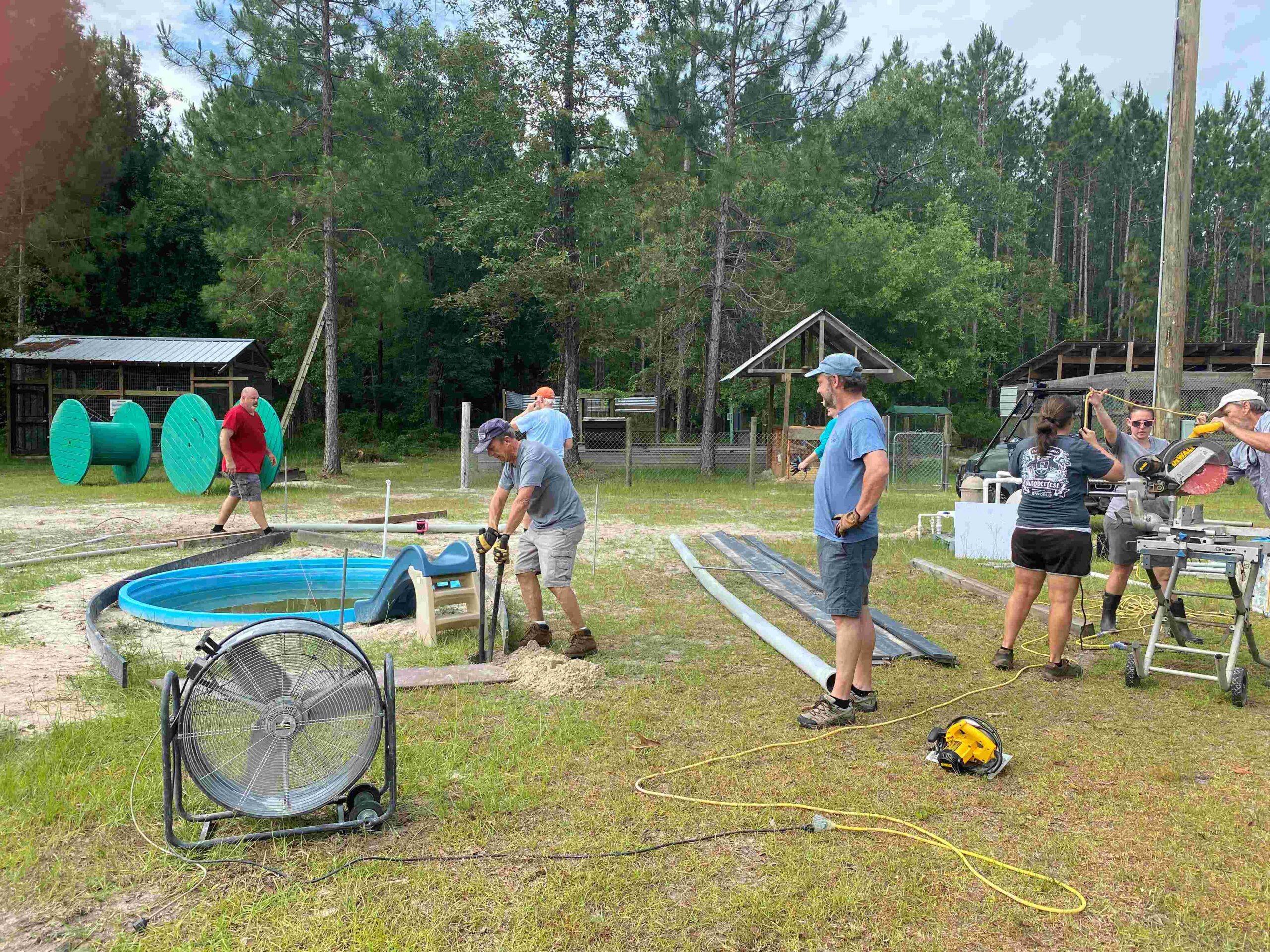By Pat Foster Turley, Ph.D.
July 1, 2021

For years now I’ve been hearing about the Ark Wildlife Care and Sanctuary (“the Ark”) where Nassau County’s rescued mammals are cared for, but I never had a chance to visit. But when I heard that they had a few rescued and orphaned otters I knew I had to try. Although this facility is not generally open to the public, when I learned of a work day there for volunteers I saw my chance.
So, one June Sunday I drove to the other side of Nassau County and followed my GPS down a dirt road in Hilliard to the Ark. This work day, their yard was full of volunteers digging a pool, setting up fencing and various other tasks involved in creating yet another enclosure for their otters. Another team, led by a veterinarian, was sorting through the medical supplies in the office, putting things in order and noting things that were needed. Still more teams were scattered about, engaged in various other projects that needed attention.
It took me a while to find the director, Jonathan Howard, who was running from team to team supervising the work. I introduced myself as a former zookeeper who raised orphaned baby otters in my home years ago and walked them on leashes at Marine World-Africa USA throughout their long life. I had some photos on my IPhone to show him. Jonathan loves otters like I do and he and I were bonded at once.
His volunteer organization is the only certified rehab facility for mammals in Nassau County and his group has successfully treated hundreds of injured or orphaned mammals ranging from tiny flying squirrels to large deer and coyotes and every mammal in between. This work is done with oversight from the Florida Fish and Wildlife Conservation Commission and the help of veterinarians, certified animal fosterers and a host of volunteers. Those animals that are successfully raised or treated are returned to the wild as soon as possible. But some of these animals have injuries or ailments that would prevent them from living on their own and others are too imprinted on humans to be released. The Ark now houses a menagerie of such animals, including coyotes, foxes, raccoons, deer and a few exotic animals like emus and African spurred tortoises thrown into the mix.

But of all these, it is the otters that are dearest to Jonathan’s heart. When he got a moment away from managing the volunteer work crews, he took me on a personalized tour of the otters maintained at the Ark. Two adult otters, Gangsta and Felony, were permanent residents. One suffers from epilepsy and is on daily doses of medication. The other was raised as an orphaned cub but developed eye problems that interfere with its ability to catch fish. Both had their own enclosures, with swimming pools, slides, toys and plenty of land area to move around in, far beyond the USDA mandated enclosure regulations.
Jonathan’s attention was needed elsewhere but his wife Mendy took over for the best part of the otter tour. She invited me into their home to see the orphaned otter cubs they were fostering in their bathroom. On the way in, she apologized for the clutter and said that “Ruby” I think her name was, was loose in the house. A little dog ran up to me. This must be Ruby? But no, she told me, Ruby was a coyote. I hesitantly asked, “How big is this coyote?” as I followed her into the house. The coyote was just a pup, it turns out, but I never did see it.

No matter. What I did see warmed my heart and brought me back thirty some years ago. Two 12 week old cubs were in the bathroom, safely confined in a dry bathtub. At this age they still need to be bottle fed occasionally but can begin to eat solid food too. In the wild they would stay with their mother for about a year, learning all they need to make it on their own. But here the caretakers needed to teach them to catch fish and other prey and to eventually cope with a wild life. The otter enclosure being built by volunteers is designed to accommodate this training, and it can’t happen soon enough. The two young otters I saw were just getting ready to climb out of the tub and explore a bigger world. Hopefully, with time and training these two otters can be released to the wild to live out their lives.
If you want to learn more about the Ark or to volunteer or make a donation, see their website https://www.thearkwildlifecareandsanctuary.com/. This worthwhile 501c3 nonprofit group can use all the help it can get!
Pat Foster-Turley is a zoologist on Amelia Island. She welcomes your nature questions and observations. [email protected]

Many thanks to Pat for another interesting article about The Ark that is right here in our own county. This sounds like a worthy place that would appreciate donations.
Hope this will flourish like the CROW’s Wildlife Hospital and Visitor Education on Sanibel Island..
Thanks for another awesome story Pat, as it reminds me of my own personal experience raising a female African Lion Cub named Mindy from about 12 weeks old and still feeding her a bottle. Unfortunately, she was diagnosed with a serious bone-marrow disease called Rickets at 2-1/2 years old.